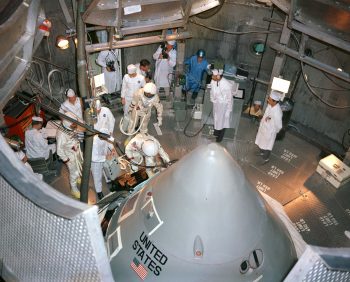Today was the Initial Power-On (IPO) of the Orion vehicle destined for Artemis II, which will bring humans around the Moon and back for the first time in over 50 years.
In our last update, Orion’s crew and service modules were connected; today, the vehicle was powered up to make sure the modules are working together as they should. This means ensuring that the crew and service modules are communicating correctly with each other, and that the power from the European Service Module (ESM) is distributed correctly to the crew module.
The IPO itself only takes a few hours: “The power-on process is very quick; it’s not so different from connecting all the appliances in your apartment and then switching on the light to make sure it works,” says Dominique Siruguet, ESM assembly integration and verification engineer at ESA.

The cone-shaped crew module being stacked over the service module below it at Kennedy Space Center.
Credits: NASA
What’s next?
Now that the IPO was successful, Orion teams will test the vehicle over the coming weeks in many ways to confirm all subsystems are functioning correctly; for example, the ability of the service module to transfer power from the solar arrays to the crew module, as well as the capacity of the service module to switch to redundant units in case of contingencies.
An important upcoming test is the “closed-loop mission test”, a sort of dress rehearsal of Artemis II. “During a closed-loop mission test, we simulate the full mission scenario, mimicking the conditions of all the different mission phases from pre-launch, to launch and separation, and all the way back to Orion’s return to Earth,” explains Dominique.
“It is the first time this kind of test is being performed for the service module. The IPO will take about one or two weeks; we inject the parameters of the different mission phases into the service module and check that all navigation, propulsion and other subsystems are reacting correctly to maintain the mission course,” adds Dominique.
Stay tuned to read about the next Artemis II milestones, including testing Orion in the same vacuum altitude chamber used during the testing of the Apollo missions!

Apollo 1 crewmembers in 1966 in the same altitude chamber that Orion will soon be tested in at the Neil Armstrong Operations & Checkout Building in NASA’s Kennedy Space Centre.
Credits: NASA
The European Service Module is part of ESA’s Terrae Novae exploration programme leading Europe’s human journey into the Solar system.

 Automated Transfer Vehicle page
Automated Transfer Vehicle page ATV blog archive
ATV blog archive
 NASA Orion page
NASA Orion page NASA Artemis
NASA Artemis Airbus Orion page
Airbus Orion page
Discussion: no comments